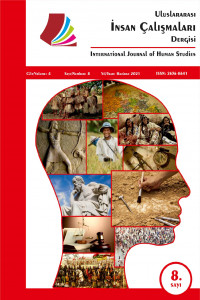Animal Studies in Contemporary British Drama: The Divide between Stef Smith’s Non-Human and Human Animals
Öz
Anahtar Kelimeler
Animal Studies Stef Smith Human Animals Anthropocentrism Speciesism
Kaynakça
- Adamson, P., and Edwards, G. F. (2018). Animals: A History. Oxford University Press.
- Beauchamp, T. L., and Frey, R. (2011). The Oxford Handbook of Animal Ethics. Oxford University Press.
- Billington, M. (2016). Human Animals review – fur flies in chilling vision of dystopian London. The Guardian. Retrieved from https://www.theguardian.com/stage/2016/may/25/human-animals-review-royal-court-theatre
- Braidotti, R. (2013). The Posthuman. Cambridge: Polity.
- Cowan, Isla. (2021). Pests and people in Stef Smith’s Human Animals. New Theatre Quarterly 37 (2), pp. 159-173.
- Gruen, L. (2011). Ethics and Animals: An Introduction. Cambridge University Press.
- Kalof, L. (2017). The Oxford Handbook of Animal Studies. Oxford University Press.
- Marvin, G., and McHugh, S. (2014). Routledge Handbook of Human-Animal Studies. New York: Routledge.
- Matsuoka, A., and Sorenson, J. (2018). Critical Animal Studies: Towards Trans-Species Social Justice. Rowman & Littlefield.
- McCance, D. (2013). Critical Animal Studies: An Introduction. SUNY Press.
- Nocella II, A. J., Sorenson, J., Socha, K., and Matsuoka, A. (2014a). INTRODUCTION: The Emergence of Critical Animal Studies: The Rise of Intersectional Animal Liberation. Counterpoints, 448, pp. xix–xxxvi. http://www.jstor.org/stable/42982374
- Nocella II, A. J., Sorenson, J., Socha, K., and Matsuoka, A. (2014b). Defining Critical Animal Studies: An Intersectional Social Justice Approach for Liberation. Peter Lang Gmbh, Internationaler Verlag Der Wissenschaften.
- Ohrem, D., and Bartosch, R. (2017). Beyond the Human-Animal Divide: Creaturely Lives in Literature and Culture. Palgrave Macmillan.
- Ortiz-Robles, M. (2016). Literature and Animal Studies. New York: Routledge.
- Pham, J. (2018). “The spectral and the comic animal in contemporary British theatre.” L’Atelier 10 (1), pp. 45-61.
- Smith, S. (2016). Human Animals. London: Nick Hern.
- Smith, S. (2020). Human Animals post-show discussion [Video]. YouTube. https://www.youtube.com/watch?v=t-BA8Qoiot4
- Taylor, P. (2016). Human Animals, Royal Court London, theatre review: A very promising debut. The Independent. Retrieved from https://www.independent.co.uk/arts-entertainment/theatre-dance/reviews/human-animals-royal-court-london-theatre-review-a-very-promising-debut-a7046636.html
- Turner, L. (2018). Edinburgh Companion to Animal Studies. Edinburgh University Press.
- The Institute for Critical Animal Studies. (n.d.). Retrieved from https://www.criticalanimalstudies.org/about/
- Voigts, E. and Tönnies, M. (2020). “Posthuman dystopia: Animal surrealism and permanent crisis in contemporary British theatre.” JCDE 8 (2), pp. 295-312.
- Waldau, P. (2013). Animal Studies: An Introduction. Oxford: Oxford University Press.
- Weil, K. (2012). Thinking Animals: Why Animal Studies Now? Columbia University Press.
- Wolfe, C. (2009). Human, all too human: “Animal studies” and the humanities. PMLA/Publications of the Modern Language Association of America, 124(2), pp. 564-575. doi:10.1632/pmla.2009.124.2.564
Çağdaş İngiliz Tiyatrosunda Hayvan Çalışmaları: Stef Smith’in İnsan Olmayan ve İnsan Hayvanları Arasındaki Fark
Öz
Anahtar Kelimeler
Hayvan Araştırmaları Stef Smith Human Animals İnsan Merkezcilik Türcülük
Kaynakça
- Adamson, P., and Edwards, G. F. (2018). Animals: A History. Oxford University Press.
- Beauchamp, T. L., and Frey, R. (2011). The Oxford Handbook of Animal Ethics. Oxford University Press.
- Billington, M. (2016). Human Animals review – fur flies in chilling vision of dystopian London. The Guardian. Retrieved from https://www.theguardian.com/stage/2016/may/25/human-animals-review-royal-court-theatre
- Braidotti, R. (2013). The Posthuman. Cambridge: Polity.
- Cowan, Isla. (2021). Pests and people in Stef Smith’s Human Animals. New Theatre Quarterly 37 (2), pp. 159-173.
- Gruen, L. (2011). Ethics and Animals: An Introduction. Cambridge University Press.
- Kalof, L. (2017). The Oxford Handbook of Animal Studies. Oxford University Press.
- Marvin, G., and McHugh, S. (2014). Routledge Handbook of Human-Animal Studies. New York: Routledge.
- Matsuoka, A., and Sorenson, J. (2018). Critical Animal Studies: Towards Trans-Species Social Justice. Rowman & Littlefield.
- McCance, D. (2013). Critical Animal Studies: An Introduction. SUNY Press.
- Nocella II, A. J., Sorenson, J., Socha, K., and Matsuoka, A. (2014a). INTRODUCTION: The Emergence of Critical Animal Studies: The Rise of Intersectional Animal Liberation. Counterpoints, 448, pp. xix–xxxvi. http://www.jstor.org/stable/42982374
- Nocella II, A. J., Sorenson, J., Socha, K., and Matsuoka, A. (2014b). Defining Critical Animal Studies: An Intersectional Social Justice Approach for Liberation. Peter Lang Gmbh, Internationaler Verlag Der Wissenschaften.
- Ohrem, D., and Bartosch, R. (2017). Beyond the Human-Animal Divide: Creaturely Lives in Literature and Culture. Palgrave Macmillan.
- Ortiz-Robles, M. (2016). Literature and Animal Studies. New York: Routledge.
- Pham, J. (2018). “The spectral and the comic animal in contemporary British theatre.” L’Atelier 10 (1), pp. 45-61.
- Smith, S. (2016). Human Animals. London: Nick Hern.
- Smith, S. (2020). Human Animals post-show discussion [Video]. YouTube. https://www.youtube.com/watch?v=t-BA8Qoiot4
- Taylor, P. (2016). Human Animals, Royal Court London, theatre review: A very promising debut. The Independent. Retrieved from https://www.independent.co.uk/arts-entertainment/theatre-dance/reviews/human-animals-royal-court-london-theatre-review-a-very-promising-debut-a7046636.html
- Turner, L. (2018). Edinburgh Companion to Animal Studies. Edinburgh University Press.
- The Institute for Critical Animal Studies. (n.d.). Retrieved from https://www.criticalanimalstudies.org/about/
- Voigts, E. and Tönnies, M. (2020). “Posthuman dystopia: Animal surrealism and permanent crisis in contemporary British theatre.” JCDE 8 (2), pp. 295-312.
- Waldau, P. (2013). Animal Studies: An Introduction. Oxford: Oxford University Press.
- Weil, K. (2012). Thinking Animals: Why Animal Studies Now? Columbia University Press.
- Wolfe, C. (2009). Human, all too human: “Animal studies” and the humanities. PMLA/Publications of the Modern Language Association of America, 124(2), pp. 564-575. doi:10.1632/pmla.2009.124.2.564
Ayrıntılar
| Birincil Dil | İngilizce |
|---|---|
| Konular | Sanat ve Edebiyat |
| Bölüm | Makaleler |
| Yazarlar | |
| Yayımlanma Tarihi | 25 Aralık 2021 |
| Gönderilme Tarihi | 5 Ekim 2021 |
| Kabul Tarihi | 24 Aralık 2021 |
| Yayımlandığı Sayı | Yıl 2021 Cilt: 4 Sayı: 8 |



